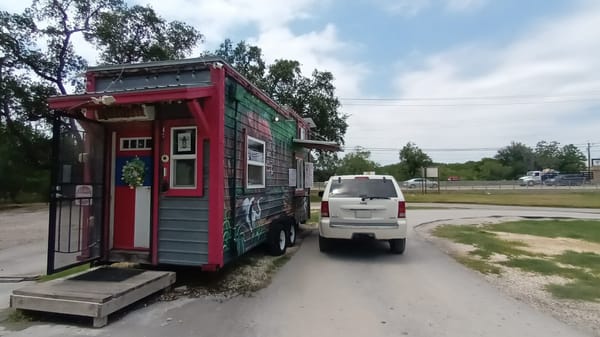How To Prepare For Freezing Weather In Texas
Every region of Texas has experienced freezing temperatures. So no matter where you live, it's important to learn how to prepare for freezing weather in Texas.

Texas is a massive state that features a wide variety of climates year-round. And while most people don't think of Texas as a state that experiences freezing temperatures, there most certainly are area's that routinely experience freezing weather.
In fact, every region of Texas has experienced freezing temperatures at some point - some more frequently than others.
It doesn't matter if you live in El Paso, Austin, Houston, Dallas, Waco, Lubbock, or any other city. Freezing temperatures in Texas are possible all across the state.
So no matter where you live in the great state, it's important to learn how to prepare for freezing weather in Texas.
Select any of the following to jump to that section:
ExpertTexan.com participates in affiliate programs. Any link you click may be an affiliate link. As an Amazon Associate I earn from qualifying purchases.
Freezing Weather Dangers
When the temperature drops below 32 degrees Fahrenheit, you are immediately faced with dangers that are not present at 33 degrees.
Some of the potential issues you may face are:
- Water pipes breaking
- Cars not starting up (improper coolants, frozen gas lines, dead batteries, etc)
- Icicles forming/falling from the roof, balconies, or any other raised platform
- Gutters backing up and freezing into the roof-line
- Unsheltered animals at risk of freezing
- Ice on sidewalks, steps, decks, landings and roadways or bridges
- Heaters catching on fire (HVAC & Space Heaters)
- Difficulty keeping the house warm due to poorly sealed doors, windows or other openings.
- Ice freezing car doors shut
And there are a lot of other risks, but you get the point.
Here are 10 things you can do to protect your home

While this article certainly does not cover an exhaustive list of things that you can - or should - prepare for when it comes to freezing weather, I've done my best to highlight the most common issues, as well as the easiest ways to address them before they become a serious problem.
Some of them you may have heard a thousand times, and others you may learn for the first time; either way, it's always good to get a refresher:
Protect your water lines
We'll start with the most common thing you hear about when the cold weather strikes fast - water lines.
This is typically not an issue with newer homes, however, if the temperature gets too far below freeing - or you live in an older house - you may want to do the following:
- Let your faucets drip all night long to keep water moving through the lines and help prevent freezing.
- Open your cabinet doors under sinks to allow warm air from the house to fill in the space.
- Cover your exterior hose faucet with an insulated cap.
- Wrap any exposed exterior water lines with pipe wrap or spray with insulation foam.
- Make sure all water hose lines have been completely drained of water, and are hung up to drip dry.
- If you have water lines in un-heated spaces such as washing machines in a garage, then you'll want to cut the water off to those, and drain the water line to the machine.
- Turn off your sprinkler system, and drain the lines of all water.
- Winterize your pool.
Taking these precautions should help you avoid any headaches and damages from potential water lines breaking due to freezing temperatures.
Apply de-icing material to exterior surfaces
There is nothing quite like walking outside in the morning to start your day, only to find yourself completely out of control as you slip, slide and fall down onto the rock-hard surface underneath you.
Not only is it not fun, it's downright dangerous and possibly even deadly.
It's important to note that icy conditions can exist even if there was no precipitation leading up to the freezing weather.
That means that even if there was no rain today, if it's going to be freezing weather overnight; your steps, sidewalk, decks, etc, could all be icy and dangerous in the morning.
The quickest and easiest way to deal with that is to simply apply de-icer to your exterior surfaces. This de-icer is pet-friendly, so you don't have to worry about your pets health when using it.
However, even if you do apply de-icer, make sure you carefully test the surface before walking out the door.
Have candles on-hand at all times
In the event that the electricity goes out during a winter freeze in Texas, there are ways that you can create "candle space-heaters" in an emergency situation.
Just having matches, candles, tin foil and/or a clay pot could be a life-saver during deep freezes that occasionally hit even the southernmost portions of Texas.
Bonus points if you have a tent that you can set up inside a small room.
If the electricity goes out and you do not have a wood stove or fireplace, this is one of the simple ways you can stay warm during freezing weather in Texas:
- Set up the tent in a small room (or most insulated room) in the house
- Layer over the tent with blankets and sheets
- Inside the tent, create a "candle space heater" using candle(s), tin foil and/or a clay plant pot.
- Stay inside the tent to keep warm
Always set it up it on a hard, non-flammable surface, and make sure someone is always awake and present to keep an eye out on it.
Clean your gutters out
This recommendation may seem a bit odd for winter time, but it's definitely important.
When your gutters are filled with any type of debris or blockage, the water from the roof cannot adequately drain out. And Texas does see quite a bit of rain during the winter, oftentimes right before the temperatures drop.
If freezing temperatures fall in, the water that's sitting there can freeze.

That can cause damage to the gutters, the roofline where the ice can swell and freeze up under the roofing, as well as form dangerous icicles over the edge of the gutter.
Have your HVAC system serviced
If you haven't used your heater in a while, chances are, there will be dust build-up on the heating coils.
Depending on the amount of dust and the type of HVAC system you have, you could experience a burning smell when first turning it on.
In most cases, the mild burning smell will fade after the heater has been on for a few minutes, but it's always better to be safe rather than sorry.

There is a potential risk of a fire anytime heat and combustible materials are involved, including dust, so it's always best to have it serviced before using it if the heater has sat unused for an extended period of time.
Prior to getting into extremely cold weather, it's best to have the HVAC system serviced to check on fluid levels on your system and to ensure it's operating at optimum performance levels.
The last thing you want is for the weather to drop to 20 degrees and have your heater fail.
Inspect and clean your chimney and fireplace
Anytime you're dealing with fire, you definitely want to play things safe.
And since freezing temperatures are the ideal time to light up the fireplace or wood stove, you'll want to make sure that you can do so safely.

Creosote build up in the chimney is often the first thing that people think about when considering chimney or fireplace safety. While that's certainly a good thing to check for, there are other issues to check for as well.
Some of them might be:
- Dampers that are cracked or not working efficiently
- Chimney or wood stove pipe spark shields and rain/snow caps
- Leaks around the chimney roof line
- Cracks in the fireplace wall or wood stove
An inspection conducted by a chimney sweep company should be sufficient to address all of your concerns and highlight any risks that may be present prior to using your wood stove or fireplace.
Space heater safety checks
Even with modern technology, space heaters still rank as one of the top reasons for house fires in the US.
The National Fire Protection association states that heating equipment accounts for 43% of all house fires and 85% of associated deaths. That's true in every state, including Texas.
And the number of house fires as a result of space heater use tends to skyrocket during freezing weather in Texas.
And while this list is definitely not the full list of precautions to take, it's a good place to start:
- NEVER plug in a space heater to any kind of extension cord, or outlet extensions of any kind. ALWAYS plug it directly into the outlet on the wall - after verifying that the outlet can handle the amperage of the heater you are using.
- Test the heater to make sure it shuts off when tipped over. If not, the safety mechanism on it is likely broken and it shouldn't be used.
- Get a new one with a tip-over sensor that will auto-shut off the heater if it's tipped over.
- Never use a space heater within several feet of anything that's even remotely combustible (e.g. clothing, carpeting, paper, etc).
- Make sure the space heater is on a hard, solid and stable surface.
- NEVER leave a space heater on and unattended.
- When in doubt, throw it out.
If it can be avoided, it's best to not use space heaters at all.
If you HAVE to use a space heater, then make sure it's NOT in use while you are asleep, and make sure someone is always awake and present in the room while it is on.
Fire extinguishers: Expiration dates, pressure and more
Despite taking every precaution possible, winter weather increases the potential risk for fire no matter what you do.
Because of that, you need to make sure that you:
- Have a fire extinguisher(s) in the house.
- Verify the certification/expiration date on the extinguisher is still valid.
- Make sure the extinguisher pressure is good.
- Make sure you know how to use a fire extinguisher in an emergency.

If you're unsure about your extinguisher - or aren't sure how to use it - simply swing on by your local fire department and ask them to take a look, and even show you how to use it in the event of a fire.
Any fire department will be more than happy to help you.
Smoke and C/O detectors: Test, batteries and more
Because house fires can spread faster than you could possibly imagine - and seconds can mean a difference between life and death - it's important for you to know as early as possible, when a fire has started.
Oftentimes, from the moment you hear a detector go off, you barely have enough time to just get everybody out of the house. Even then, you're fortunate to escape at all - some people never do.
Building codes in most areas require that you have a smoke detector in every single room in the house, as well as in all hallways and stairway area's.
But not only should you have them all over the house, you also need to make sure you routinely test them and change out their batteries.
There's never a bad time to do that. It's just important that you do it frequently.
So right now is a good time to go check all of your smoke and C/O detectors.
If you have gas in the house, or any appliances or heat sources that put off C/O, you'll need to make sure you have C/O detectors too (the one's I linked to above are combo smoke and C/O detectors).
If your detectors are more than 10 years old, it's time to replace them.
Have a backup plan in place
Sometimes the weather can have nasty surprises in store for even the most prepared people.
It usually comes in the form of things that are out of your control like; the power goes out, water pipes break, water mains explode on the main street, streets ice over, etc.
For those scenarios, it's good to have a backup plan in place.
Some back-up plans might be:
- Have bottled water in the house.
- Have a fire or propane grill handy for cooking outside.
- Stay at a friend or families place outside of the danger zone.
- Have funds set aside for an emergency hotel stay.
- Have emergency flashlights (w/ a battery backup) and/or candles ahead of time.
- Have emergency food packs that don't require cooking.
Have an emergency bag/kit ready to go
A good side-kick to an emergency backup plan is an emergency bag/kit that's ready to go when you are.
I actually recommend this for anybody to have ready at all times. You never know when you will have an emergency pop up and you won't have time to pack - or do anything else but grab a bag and leave the house.

Some things an emergency bag might have are:
- AA & AAA batteries
- Flashlight
- Road flares
- First Aid Kit
- Emergency thermal blanket
- Non-perishable/dehydrated food packs
- Charger cables (phone, laptop, tablet)
- Portable battery pack (charged up)
- Change of clothes (1-2 sets)
- Backup Photo ID (passport, copy of driver's license, etc)
- Emergency credit card
And yes, I realize this sounds more like a bag that Jason Bourne might have, but you'd be surprised how handy it is to have in an emergency situation.
Seal off all drafty windows and doors
One of the easiest ways to create a really high energy bill for yourself is to have drafts throughout the house that allow cold air to blow in with little effort.
Generally you'll find drafts around doors and windows.
For windows, you can seal them off for the coldest winter months with a plastic window seal. For doors, you'll want to make sure that the weather stripping all around the door is good and flush up against the door when it's closed.
If there's a draft underneath the door, there are super-easy-to-install door sweeps and other products that you can put on the bottom of the door to seal it off and prevent air from coming in or going out.
Here are 6 things you can do to prepare your car for freezing weather
A lot of the news coverage you see on TV during the winter season revolves around the house. But the truth is, your car needs some TLC during freezing weather too.
I'm guilty of focusing on the house, too.
While I have written extensively on the topic of protecting your car from would-be thieves and burglars, I have never written about protecting your vehicle from the elements during the winter months.
So let's remedy that, shall we?
Here we go...
Get an ice scraper for your window
When I first moved to Texas, I did not think that I'd ever have a need for an ice scraper ever again.
I was wrong.
If you don't want to have to sit in your car for 10-15 minutes waiting for your windows to defrost, you may as well just get a window scraper.
In fact, just get an ice scraper with the brush on it as well, for those random, occasional snow storms.
Trust me, you'll be glad you have it when you need it.
Fill up your gas tank and keep it full
While this is a hotly debated topic - it's best to err on the side of caution, and keep your gas tank at least 1/2 full during freezing weather.
Even though auto technology has improved over the years, and fuel-injection technology is much more efficient, there's still a small risk of condensation getting into the fuel lines and potentially freezing and/or corroding your engine or gas tank over time.
Having your gas tank at least 1/2 full at all times virtually eliminates the chance of that ever happening.
There will be plenty of people who say this is completely unnecessary, but, you may actually find that this recommendation may also be hidden in your vehicles owner manual.
If nothing else, it adds additional weight to your vehicle to provide better stability and traction control on the road.
Check your fluids - especially the coolant
No matter what time of year, checking your vehicles fluid levels is important to do on a regular basis, but it's especially important to check your engine coolant levels during the winter.
Most engine coolant these days comes with antifreeze in it already, which means that it will help your engine from freezing during extremely cold weather.
Having low levels of engine coolant - or none at all - can cause extreme damage to your vehicle.
While you're checking on the engine coolant level, be sure to check your oil, windshield wiper fluid, etc.
If you aren't sure what's what - just bring your car by a local mechanic shop and have them top everything off for you.
Check the battery
You're headed out the door into the freezing weather, put your key into the ignition and turn it clock-wise - click click click - what the?!
The vroom vroom in your zoom zoom isn't vrooming. All you hear is a clicking sound.
Chances are, it's your battery.
The good news is, you can avoid this scenario entirely because your battery will usually have warning signs that it's losing the ability to stay charged as it gets weaker over time.
The quickest and easiest way to check your battery is to either buy a battery tester, or swing by your local auto-parts store.
Most major auto parts stores will be able to test your battery to see how much life it's got left in it and if it's at risk of dying in the near future.
If it comes back with a poor reading, it's time to swap it out.
Check your air in your tires
Not much else can ruin an otherwise good day like a tire problem on your car.
Especially if it's freezing outside.
You can get some pretty cheap tire pressure checkers to keep in your car, and check your tire pressure on a regular basis.
If you're driving a relatively newer car that has a pressure sensor built in, and the light goes off or gives you a low pressure reading, you'll want to get your tires back into shape with the proper pressure.
Having low pressure in your tires can lead to a lot more damage than just a flat tire.
It could cause alignment issues, gas mileage issues, traction control issues and other problems you may not even be aware of until you're paying money to fix them.
While you're checking your tire pressure, take a quarter - with Washington's head facing down - and place it between the tread lines of your tire.
If you can see the top of Washington's head above the tread line, it's time to replace the tire!
Wash and wax your car
I know.
I realize this is an odd suggestion, but until you've lived up North (I mean like a Michigan kind of north...), you have probably never seen the devastating effects of how much havoc winter road treatments can wreak on your car.
Suffice it to say, after you've driven on roads that have been given winter road treatments, you'll want to go get your vehicle washed.
Under-carriage and everything.
In fact, you should probably get a pre-wash and pre-wax before the winter season too.
You can thank me later!
How to protect your outdoor pets in freezing weather
This topic could actually be an entire article on it's own, but I wanted to touch on some of the most important factors when it comes to protecting your outdoor pets in freezing weather.
Many outdoor pets can survive in freezing weather
I know that this isn't a popular statement, and many people will disagree with me and some may even be angry that I dared to say this - but it's true.
Many outdoor pets can - and do - survive in freezing weather.
In fact, some of them thrive in it and love it.
If animals couldn't survive in freezing weather, then we wouldn't have anywhere near the number of stray animals on the streets and roaming the countryside that we do.
Many domestic animals - primarily dog breeds - were bred specifically for colder weather climates.
Dogs like the Bernese Mountain Dog, the Great Pyrenees, etc, are great examples of dogs that typically do just fine in freezing temperatures.
That being said, it's always best to err on the side of caution when it comes to pets and - if possible - bring them inside when the temperature drops below 32 degrees.
Proper shelter and bedding for outdoor pets in freezing weather
In some cases, it's simply not possible to bring pets inside.
Whether it's allergies, or some other scenario that's preventing you from being able to bring them inside, it's still important to make sure that outdoor pets have access to proper shelter and bedding.
The best places to offer shelter for your outdoor pets is typically a garage, shed, or other building on the property that offers adequate protection from the elements.
In addition to a solid roof and four walls, you'll want to make sure that you have adequate bedding for them.
If you're going with a natural bedding material, one of the best ones is straw (NOT hay! - MUST BE STRAW!).
Straw is mildew, mold and moisture resistant, which helps to retain heat and provide a warm, dry place for pets to sleep on. A nice fluffy bed of straw is a great solution for warm bedding in cold weather.
Alternatively, you can purchase bedding for pets that's manufactured specifically for outdoor use, though, in my experience, it's not as good as straw.
Unless you have access to a power source outside, then warm bedding mats for pets are certainly an option for you.
Proper nutrition for outdoor pets in freezing weather
Another often-overlooked requirement for keeping pets healthy outdoors in freezing weather is making sure that they have the proper nutrition.
Water (make sure it's not frozen over) and nutritional food are essential to helping outdoor animals retain their heat and keep their body's operating at optimum performance levels.
Some pet food companies will specifically label their bags of food as being for "outdoor pets", and those bags of food are typically filled with the nutrition that they need to enjoy the outdoors, even in cold weather.
Should my outdoor pet come inside?
If you're unsure if your pet is properly equipped to withstand freezing temperatures outdoors, it's always best to check with your pet's veterinarian.
When in doubt, bring them inside.
Recap: How to prepare for freezing weather in Texas
If you made it this far in the article, congratulations! You just read over 3,000+ words.
If you just skipped to this section to get to the summary - smart move!
To recap, this is how to prepare for freezing weather in Texas:
Home Preparation
- Protect your water lines.
- Apply de-icer to exterior surfaces.
- Clean your gutters out.
- Service your HVAC system.
- Inspect and clean your chimney and fireplace.
- Don't use space heaters - if you have to, read this section above.
- Inspect your fire extinguishers, know how to use them
- Test your smoke and C/O detectors
- Have a backup plan in place
- Have an emergency "go bag" (see content details in section above)
Car Preparation
- Get an ice scraper with a brush
- Fill up your gas tank and keep it full
- Check your fluid levels
- Check your battery health
- Monitor your tire pressure
- Wash and wax your car
Pet Preparation
- Provide exterior shelter
- Provide warm, dry bedding
- Provide adequate nutrition and water
- Bring them inside - if possible
Did I miss anything? If so, let me know in the comments below!
Stay safe out there!




